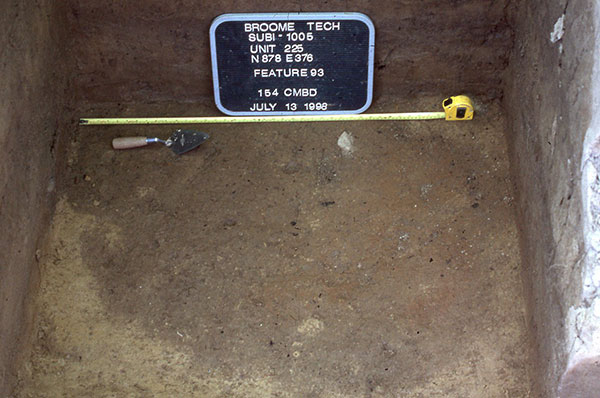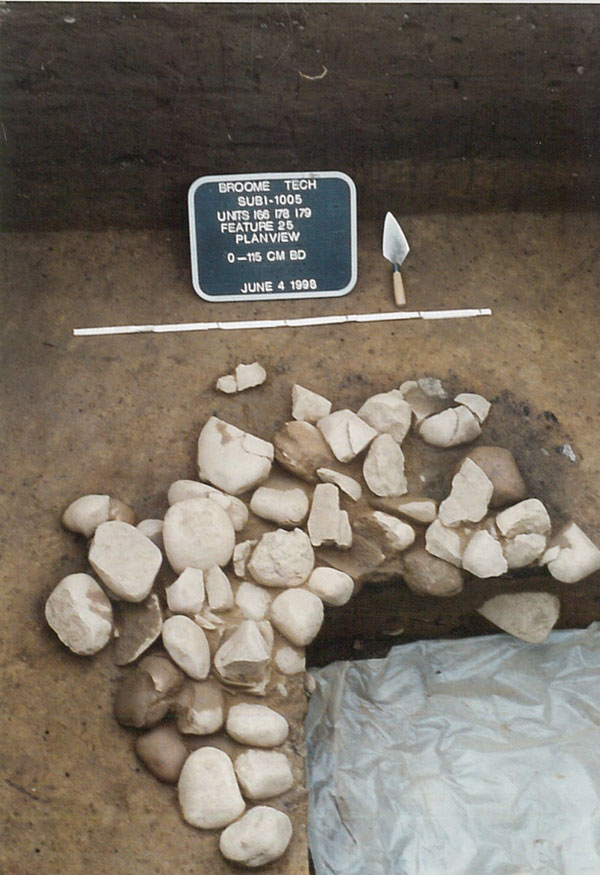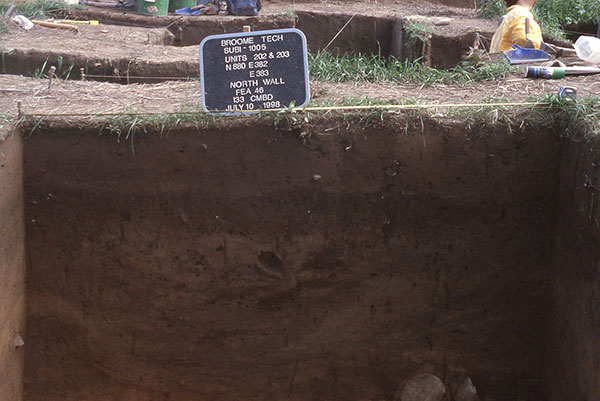Archaeologists identified a variety of feature types at the Broome Tech site, including cooking/heating and storage features, although not all feature types were present during each period of site use. Archaeologists identified 78 features across all prehistoric occupations of the site.
In addition, archaeologists found 60 post molds and seven possible post molds. Post molds are features representing the location of posts that were driven into the ground or placed into predug holes. They are the only evidence for above ground architecture in the Northeast. No palisades (fences) or residential structures were seen in the post mold patterns at Broome Tech. The posts probably represent more ephemeral structures (e.g., drying racks, temporary lean-to shelters, etc.).
Over half of the 27 features associated with the Transitional component at Broome Tech are hearths. Hearth features are common on many prehistoric sites and represent open fires used for cooking, resource processing, heating, and light. Excavations also identified smaller numbers of shallow pits and charcoal concentrations, as well as one possible post mold.

Archaeologists identified 21 features associated with the Middle Woodland period of site use. As with the Transitional component, hearths are over half of the features associated with this period. Other features identified include small pits, FCR or charcoal concentrations, and roasting platforms. Archaeologists also identified 31 post molds and three possible post molds.

Hearths represent almost three-quarters of the 24 Late Woodland period features. Other feature types include a large storage pit and smaller pits. Seventeen post molds and three possible post molds were also identified. The large number of hearths indicates their importance for heating and/or cooking activities. These Late Woodland hearths are thin, fire-reddened stains, made with little or no investment in preparation. The single storage pit identified is quite large and contains deep and complex stratigraphy indicating reuse.

Food remains from Broome Tech include both faunal and floral remains. Archaeologists recovered few animal remains from the site. These were limited to vertebrate bones and mammal bones that could not be attributed to a specific species. It is most likely that these bone fragments represent the remains of game animals (possibly white-tailed deer). The recovery of numerous projectile points at the site suggests that hunting was a major activity practiced at the site and processing and cooking of game animals likely occurred as well.
Archaeologists identified plant remains from Broome Tech features associated with all major periods of site use. Analysts identified nutshell in low quantities from all three major periods. The Transitional period features contained bitternut hickory, butternut, and hickory, while acorn, butternut, and hickory were identified in Middle Woodland features. The Late Woodland nutshell included these same nut types, along with hazelnut. Nuts are important for the food, oils, and fuel they provide. The abundance and variety of nutshell, along with the presence of more than one type in many features, indicate that nutmeat was food during all three periods.
Remains of cultivated plants at Broome Tech include maize (Zea mays L.), associated with the Middle and Late Woodland periods, as well as squash (Cucurbita pepo) and bean (Phaseolus vulgaris L.) with the Late Woodland. Most of the maize fragments were from kernels, indicating that it was not grown at the site. If it was, we would expect more inedible cob fragments to be present.
Features contained very few seeds and most were associated with Late Woodland period of site use. Identified seeds include hawthorn, grass, sumac, bramble, dock, bedstraw, white vervain, and blueberry.